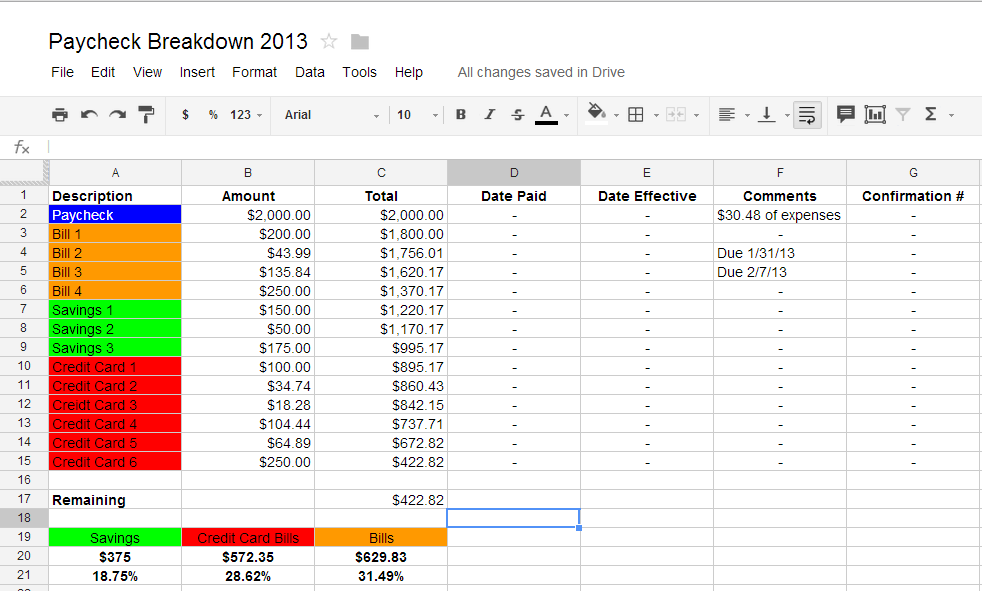2/5/15 and 3/7/15 Update:
I plan on updating this every 2 weeks which coincides with pay-day!
I’ve just started listening to Dave Ramsey and began reading his book “Total Money Makeover” – It has definitely opened my eyes to my financial situation and helped me start thinking about what I can achieve. The thing that he stresses the most is getting out of debt and never borrowing any money. He breaks down his debt-free method into baby steps for you to follow that will help you reach that point in your life where you are financially wealthy and independent. The first baby step is to save $1,000 for an emergency fund – I have this completed already. The second baby step is to start paying off all your debt starting from smallest to largest regardless of interest rate. I’m currently completing baby step 2. I haven’t listed my debts yet but I want to in this post so that I record my starting point and put my goal on paper! Below is my debt from smallest to largest and I will be DEBT FREE!!!
3/20/15:
I did a few things to reduce the debt quite substantially since my last update – the most notable items being taking out $4k of my savings and selling my silver at a 60% loss to pay off debts. I’ve also eliminated a means of income generation by no longer selling plasma due to my parent’s request; no longer selling plasma will cost me approximately $3,600 a year and 5 months to getting debt-free faster. But I’m a firm believer in filial piety therefore I will act per my parent’s wishes. I have also taken the drastic measure to stop my 401(k) contributions however I will re-contribute if I cannot complete this goal in 24 months. My current estimate shows me be doing in 26 months however this doesn’t take into the account the debt snowball method of compounding payments from paid off debt. Note: I don’t update the car balance or the parent loan balance until I reach them.
4/3/15:
I paid off all the student loans in my name!! I got this completed by withdrawing $5,000 from a savings account. I also made a huge dent into the Grace loan and soon I will have her in my hands officially.I’m going to need to start another way of finding additional income to accelerate this debt snowball therefore I think I’m going to start getting more serious about selling things on Craigslist and eBay. As far as progress goes, I’m quite proud of current pace and acceleration. I still have more money in a savings account which I’m saving as a final push for Grace.
4/17/15 and 5/1/15:
I found an additional source of income that is getting me approximately an extra $45/week. I also got my $171 check for selling my $200 Hyatt gift card. I also took out the cash I had in my brokerage account and put quite a big dent into car loan. If I’m moving at this pace, I should have the title for Grace by October!
5/15/15:
Got another additional income by starting to drive for Uber!! My first night I made $106 in fares and I get to keep approximately 74% of that so not bad for 3.5 hours worth of work! This should hopefully speed up my date – my new goal is to be done by December 31st, 2016.
5/29/15:
I got a nice bonus from Uber for $100 by completing 10 trips and also sold my broken Xbox 360 for $40. The other side job also netted me an astounding $150! Unfortunately, I did not work for Uber this weekend therefore that will affect next weeks debt update but perhaps I’ll make it up by working extra this Friday.
7/10/15:
I paid off my car loan!!! I finally have my first piece of property in my car and it feels great to not have another car payment even though the car was a very dumb decision by me! At least it’s a car that I absolutely LOVE! Paying off my 72-month car loan in 9 months definitely felt like a fantastic success. I don’t owe a dime to anybody underneath my name and now I’m onto erasing that debt that my parents took to put me through college. I haven’t driven for Uber in over a month but my start soon just so I can really start eroding this debt mound.
8/21/15:
I sold all the stock in my brokerage account and used the money to pay off debt. The majority of the capital to purchase those stocks came from my student loans so it was basically borrowing money to buy stocks, as Dave would say. This made a huge chunk in my debt levels ($9,500) and shortened my duration by 3 months or so. I’ve still been too lazy to drive for Uber and have been saying every week that I’ll start but I’m just so tired… My main goal now is to finish before I start my part-time MBA at PSU so that I can save up money to cash flow the books and tuition while I wait for the tuition reimbursement to come in (I don’t get it until I get a C or better in the class and provide documentation).
10/25/15:
Wow it’s been a long since I last updated! Well nothing new has really happened – I’m just keep on keep’n on. Oh, I accidentally paid $400 into the wrong student loan! This is truly a grueling physical and mental marathon but I’m so close I can see the finish line! I picture myself taking my family out to a nice restaurant after I finish because they have supported me 100% along the way and have also made many sacrifices to help me with this goal. I also envision myself going on the Dave Ramsey show and doing my DEBT FREE SCREAM!!
12/25/15:
Dang, it’s been exactly 2 months since my last update but a lot has happened in that short time that has accelerated my debt free snowball! I’m at that last 0.2 miles of the marathon and I can clearly see the finish line but your body is aching and every step is difficult but I’ve too far to give up now so I’m going to power through! The biggest snow angels I added to my snowball was a credit for my CarMax warranty, a Turner bonus, and an unexpected Ecomunnity bonus! I’m down to the last 2 months and I can’t believe I’m soooooooo close!!
01/22/16:
Holy poop!! I can’t believe I’m only 1 paycheck away from being debt free!!! I can actually be debt-free right now because I have the money in my savings account but I decided not to for a few reasons with one being that I might need it for taxes. Also, my next pay check will be on 2/5/16 which is the exact same date one year ago that I started to start this debt-free journey and change my life. My new saying for this journey is that I sacrificed a year of my life for an eternity of freedom.
1. $432 – Phone bill Paid 2/11/15
2. $1,645.05 – Student Loan Paid 3/6/15
3. $1,681.75 – Consumer Paid 3/6/15
4. $2,556.99 – Student Loan – Paid 3/6/15
5. $3,046.90 – Student Loan
5a. $1,748.43 – 3/7/15 Paid 3/17/15
6. $3,351.61 – Student Loan Paid 3/17/15
7. $4,433.71 – Student Loan
7a. $2,052.29 – 3/20/15 Paid 4/2/15
8. $18,968.45 – Car Loan
8a. $14,142.44
8b. $8,8188.63
8c. $6,572.57
8d. $4,260.49 Paid 7/6/15
9. $44,089.00 – Student Loan (It’s under my parent’s name but they gave me the opportunity to change my stars therefore I have no qualms about paying this back for them – broken out below).
9A. $4,493.34 Paid 7/24/15
9Aa. $2,867.71
9B. $8,513.88 Paid 8/21/15
9C. $9,792.23
9Ca. $5,817.24 Balance 8/21/15; Paid 10/2/15
9D. $10,354.67
9Da. $8,015.78 Balance 10/25/15 Paid 12/11/15
9E. $10,934.88
9Ea. $10,432.78 Balance 10/25/15
9Eb. $5,490.02 Balance 12/25/15
9Ec. $888.88 Balance 01/22/16
Original Total = $80,205.46
New Total (01/22/16) = $5,490.02
ETA Pay-off (02/05/16) = 2 WEEKS = 2/2016
New Total (12/25/15) = $5,490.02
ETA Pay-off (12/25/15) = 2 months = 2/2016
New Total (10/25/15) = $18,448.56
ETA Pay-off (10/25/15) = 6 months = 4/2016
New Total (8/21/15) = $26,836.38
ETA Pay-off (8/21/15) = 9 months = 5/2016
New Total (7/10/15) = $42,172.00
ETA Pay-off (7/10/15) = 14 months = 9/2016
New Total (5/29/15) = $48,312.71
ETA Pay-off (5/29/15) = 16 months = 9/2016
New Total (5/15/15) = $50.624.79
ETA Pay-off (5/15/15) = 19 months = 12/2016
New Total (5/1/15) = $52,240.85
ETA Pay-off (5/1/15) = 20 months = 01/2017
New Total (4/3/15) = $58,194.66
ETA Pay-off (4/3/15) = 23 months = 03/2017
New Total (3/20/15) = $64,509.40
ETA Pay-off (3/20/15) = 26 months = 05/2017
New Total (3/7/15) = $72,591.2
ETA Pay-off (3/7/15) = 34 months


